| | Español Mexicano | English |
|---|
| | Página 384 | Page 384 |
|---|
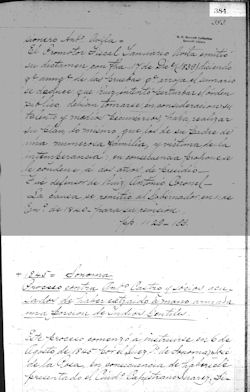
|
+ 1845 = Sonoma
Proceso contra Anto. Castro y sócios acusados
de haber extraido á mano armada una porcion de Indios Gentiles.
Este proceso comenzó á instruirse en 6 de Agosto de 1845 por el Juez So. de Sonoma, José de la Rosa,
en consecuencia de haberselé presentado el Ciudo. Capistrano Suarez,
|
+ 1845 = Sonoma
Proceedings against Antonio Castro and associates accused
of having taken by force of arms a group of pagan Indians.
This case was begun on the 6th of August of 1845 by the Supreme Judge of Sonoma, José de la Rosa, as a
result of Capistrano Suarez coming before him
|
| | Página 385 | Page 385 |
|---|
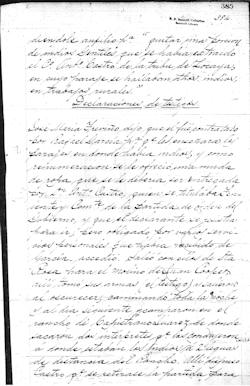
|
pidiendole auxilio pa. “quitar una porcion de indios Gentiles que se había extraido el Co. Anto. Castro
de la tribu de Locaya, en cuyo paraje se hallaban dthas. indios, en trabajos rurales.”
Declaracíones de testigos
José María Treviño dijo que el fué contratado por Rafael García pa. qe. les enseñara los parajes en donde
habia indios, y como renumeracion se le ofreció una muda de ropa que se le deberia ser entregada por Dn. Anto.
Castro, quien se titulaba Teniente y Comte. de la partida de órden del Gobierno, y que el declarante se resistia
para ir, pero obligado por varios servicios personales que habia recibido de García, accedió. Salió con ellos de
Sta. Rosa para el molino de Juan Cooper, allí tomó sus armas (el testigo) y salieron al oscurecer, caminando toda
la noche y al día siguiente acamparon en el rancho de Capistrano Suarez de donde sacaron dos intérpretes qe.
las condujeron á donde estaban los indios á 2 leguas de distancia del Rancho. Allí dispuso Castro qe. se retirase la partida para
|
requesting his assistance to “retrieve a group of pagan Indians that Antonio Castro had taken from the Locaya tribe,
the neighborhood in which the said Indians were living as farm workers.”
Witness Testimonies
José María Treviño said that he was hired by Rafael García to show them the places where there were Indians,
and as payment he was offered a change of clothes which would be given to him by Don Antonio Castro, who by order
of the Government called himself Lieutenant and Commander of the party, and that the witness hesitated going,
but obliged by the several personal services he had received from Garcia, he consented. He left Santa Rosa
with them for Juan Cooper’s mill, there he picked up his weapons (the witness) and they left at dark, walking all
night and next day they camped on Capistrano Suarez’s [Juárez (G.Farris)] ranch from where they took two interpreters that they led
to where the Indians were, two leagues from the Ranch. There Castro ordered that the party retreat to
|
| | Página 386 | Page 386 |
|---|

|
sorprender la rancheria al amanecer; pero que habiendo sido sentidos por los indios por el relincho de
un caballo salió el Capitan de dtha. rancheria y otros indias qe. lo acompañaba y encontrandose con
Rafael García, los sorprendió, dando voces a los de espedicion para qe. se reuniesen lo que verificado cayeron
de golpe sobre la rancheria qe. inerme: y sin antecedente alguno de guerra, se mantenía la paz á consecuencia
de las promesas de Dn. Cayetano Juares; qe. serían como las ocho de la noche cuando sorprendieron la rancheria
y arrancandola con violencia de sus hogares, la condujeron con familias á un llano inmediato en donde pasaron
la noche; qe. al dia siquiente de regreso llegaron al rancho de Fernando Felix en cuyo paraje se separó una parte
de los empresarios pa. ir a caer á otra rancheria con el objeto de sacar mas gente; qe. estando inmediatos ya á
la rancheria, Desiderio Briones disparó un tiro á un benado y habiéndose oído por los indios estas huyeron;
pero luego que vieron estas los interesados, apresuraron la marcha lo qe. hizo |
to surprise the village at day-break; but having been heard by the Indians due to a horse’s whiny the
Chief of the said village left accompanied by other Indians they happened upon Rafael García, he surprised
them shouting to the expedition that they gather, once ready they fell suddenly upon the unarmed village:
without any prior reason for war, peace was kept as a consequence of the promises of Don Cayetano Juares
[Juárez (G.Farris)];
it was about eight o’clock at night when they surprised the village and dragged them violently from their
homes, they led the families to a nearby plain where they spent the night; that on return next day they reached
the ranch of Fernando Felix where a group of the landowners separated to go fall upon another village with the
intent of taking more people; and being already right next to the village, Desiderio Briones shot at a deer and
having been heard by the Indians these fled; but after seeing them those concerned, hastened their pace that
meant |
| | Página 387 | Page 387 |
|---|

|
qe. encontraran á los indios dispersos y los fueron tomando en los montes sin defenza: qe. el qe.
decalara entregó los indios qe. conducía a los demás compañeros, y se unían con Pablo Briones pa. regresarse
a entrar por segda. vez en la dtha. rancheria por ver sí encontraban á la demas gente qe. habia huído.
Que habiendo entrado á la rancheria encontraron solamente dos ancianos qe. por su inutilidad los habían dejado
libres: que entonces retrocedieron pa. unirse á sus compañeros, y habiendo salido fuera del monte se encontraron
un indio mortalmente herido de un balaso qe. le quitó el carrillo izquierdo de la cara, una puñalada debajo de
la arca, y abierta la cabeza de un machetaso en la frente son los cesos de fuera: qe. Pablo Briones dijo, al qe.
declara “si hubiera agua en estas cercanías lo bautizaría pa. qe. no muriera gentil”, y como hubo esta dificultad,
dijo el segundo al primero, qe. pa. qe. no padeciera mas el moríbundo lo acabaría de matar, lo qe. verificó tirandóle
un riflazo: qe. el qe. declara con su compañero Briones, se dijieron al molino del Sor. Cooper donde los aguardaban sus |
they came upon the Indians while scattered and caught them defenseless in the woods: that the witness handed
over the Indians he was escorting to the other partners, and they joined Pablo Briones to return for a second time
to said village to see if they could find the rest of the people who had fled. That entering the village
they only found two old men that, because of their uselessness, had been left free: that they then turned back
to join their colleagues, and once out of the woods they came upon a mortally wounded Indian, a bullet-shot had
taken off the left cheek of his face, a stab below the chest, and the head opened by a machete slash to the forehead
exposed the brains: that Pablo Briones said, to the witness “if there were water hereabouts he’d baptize him so
he would not die a pagan”, and there being this difficulty, the second said to the first, so that the dying man
would not suffer any more, he would finish killing him, which he did shooting him with a rifle: that the witness
with his colleage Briones, headed to Mr. Cooper’s mill where |
| | Página 388 | Page 388 |
|---|

|
compañeros; qe. esto sucedió el dia 29 de Julio pa.po.
Pregdo Sí sabe quien hirió al indio moribundo, qe. encontraron él y Pablo Briones.
Repondió _ qe. sabe lo hirió Seberiano Castro pr. qe. el mismo lo dijo, al qe. declara en presencia de Pablo
Briones, Desiderio Briones, y Mariano Castro, Vitorico García y un Francés Tuerto, qe. no conoce de nombe.
Pregdo Sí sabia qe. hallan matado otros indios, en este caso diga lo qe. sobre el asunto sepa.
Respondió: qe. Sebariano Castro contó delante de los mismos individuos referidos, haber matado un anciano qe.
encontró en el campo: qe. Mariano Castro refirió así mismo haber matado otro indio en un arroyo; qe. la causa fué
por qe. el tal Castro se sacaba por fuerza una mujer qe. se encontró en el mismo arroyo, y qe. un indio salió á
defenderla tirándole jarazos y qe. por esa razón lo mató, según contó el mismo Mariano Castro, manifestando el
puñal lleno de sangre y aun él mismo.
Pregdo Sí pelearon con alga. rancheria de indios, respondió: qe. con ninguna, qe. al contrario estaban de paz,
y no habían hecho daño alguno á Dn. Anto. Castro ni á |
their colleagues were waiting for them: that this happened on the 29th day of July past.
Asked: Did he know who wounded the dying Indian, that he and Pablo Briones found.
Answered: He knows Seberiano Castro had wounded him because he said so himself, to the witness in the presence
of Pablo Briones, Desiderio Briones, and Mariano Castro, Vitorico García and a One-Eyed Frenchman, whom he didn’t
know by name.
Asked: Did he know if they had killed other Indians, in which case tell what he knew on the subject.
Answered: That Seberiano Castro described, in the presence of the same individuals mentioned, having killed an
old man whom he found in the fields: that Mariano Castro referred to himself as having killed another Indian in a
creek; the reason was that the said Castro was forcibly removing a woman he had found in the same creek, and that
an Indian came out to defend her throwing wooden spears and for that reason he killed him, as told by the same Mariano
Castro, showing the dagger covered in blood and even himself.
Asked: Had they fought with any Indian village, replied: that with none, that on the contrary they were at peace,
and they had not inflicted any harm upon Don Antonio Castro nor upon |
| | Página 389 | Page 389 |
|---|
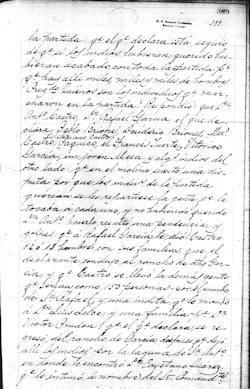
|
la partida: qe. el qe. declara está seguro de qe. sí los indios hubieran querido hubieran acabado con toda
la partida pr. qe. hay allí miles, miles y miles de hombres
Pregdo Quienes son los individuos qe. marcharon con la partida; Respondió: que Dn.
Anto. Castro, Dn. Rafael García,
el que declara, Pablo Briones, Desiderio Briones, Mars. Castro, Seberiano Castro, Paquico, el Francés Tuerta, Vitorico
García, un joven Mesa y algs. indios del otro lado: qe. en el molino suscitó una disputa por que los indivs. de la
partida querían se les repartiese la gente qe. le tocaba á cada uno, y no habiendo querido Dn. Anto. hacerlo resultó
una pendencia y golpes: qe. a Rafael García le dio Castro 12 ó 13 hombres con sus familias, que el declarante condujo
al rancho de dtho García, y qe. Castro se llevó la demás gente qe. serian como 150 personas por el rumbo de Sn. Rafael,
y una indita qe. la mandó a Dn. Luis Leecs, una familia pa. Dr. Victor Prudon; qe. el qe. declara se regresó del rancho
de García, después qe. dejó allí los indios por la laguna de Sr. Anto. en donde lo encontró Dn. Cayetano Suarez, qe.
le intimó á nombre del Sr. Comandte. |
the party: that the witness is sure that if the Indians had wanted to they could have finished off the
entire party because there are there thousands, thousands and thousands of men.
Asked: Who are the persons who went with the party; Answered: that Don Antonio Castro, Don Rafael García, the witness,
Pablo Briones, Desiderio Briones, Mariano [(G.Farris)] Castro, Seberiano Castro, Paquico, the One-Eyed Frenchman, Vitorico García, a
Mesa youth and some Indians from the other side: that at the mill there ensued an argument because the party members
wanted to receive their allotted shares of the people, and as Don Antonio didn’t want to there was a
quarrel and blows:
that Castro gave to Rafael García 12 or 13 men with their families, whom the witness escorted to the ranch of said Garcia,
and that Castro took the remaining people that would be about 150 individuals in the direction of San Rafael, and a
little Indian
girl that he sent to Don Luis Leecs [Jacob P. Leese (G.Farris)], a family for Doctor Victor Prudon; that the witness returned to Garcia’s ranch,
after leaving the Indians there near the laguna of Señor Antonio, where Don Cayetano
Suarez [Juárez (G.Farris)] found him, who in the name
of the Señor Comandante advised him |
| | Página 390 | Page 390 |
|---|

|
se presentase inmediatamente en Sonoma
El 15 de Agto. de 1845 se examinó al testigo Nazario Sais y dijo: que el día 3 llegó Dn.
Anto. Castro, Rafael García, Sebero Alviso, Manuel Saís, y el Tuerto Francés, al rancho del qe. declara inmediato á Ross):
qe. de allí se reunieron el declarante y Mariano Elizaldi por órden de Dn. Anto. Castro y se dirijieron á Ross: qe. su
objeto era llevar alguna gente pa. sus trabajos, y algunos lepes ó huérfanos qe. habiendo llegado, la indiada arrancó
al monte y quedaron unicamente en las rancherias inmediatas á la plaza, dos Capitanes qe. fueron amarrados, el primo.
por Rafael Garcia dandole muchos golpes con la culata del fusil; y el segundo arrancó y Dn. Anto. Castro mandó al
declarante qe. lo siguiese y agarrase, lo qe. verificó en violencia de la carrera de su caballo tomándolo del malote
del pelo de la cabeza: qe. al alcanzarlo se pasó la bestia y cayó el indio: qe. entonces llegó Dn. Anto. Castro y le
dio varias golpes con la espada qe. llevaba en la cinta: qe. fueron mancornada los dos Capitanes y les dijo Dn. Anto.
Castro, qe. si entregaban |
to appear immediately in Sonoma.
On the 15th of August of 1845 the witness Nazario Sais was questioned and said: that on the
3rd Don Antonio Castro, Rafael García, Sebero Alviso, Manuel Saís, and the One-Eyed Frenchman arrived at the witness’s
ranch right next to Ross: that they were joined by the witness and Mariano Elizalde by order of Don Antonio Castro and
they headed to Ross: their goal was to take some people as workers, and some
lepe [homeless (G.Farris)] or orphans that having arrived,
the Indians ran into the woods and the only ones left in the villages next to the plaza were two Chiefs who were tied
up, the first by Rafael Garcia who struck him many times with the stock of his rifle; and the second ran and Don Antonio
Castro told the witness to chase and catch him, which he did the violent charge of his horse he grabbed him by the
top-knot [(G.Farris)] of hair on his head: that on reaching him the beast ran him over and the Indian fell: that then Don Antonio Castro
arrived and hit him several times with the sword he carried on his belt: that the two Chiefs were tied together and
Don Antonio Castro told them, that if they handed over |
| | Página 391 | Page 391 |
|---|
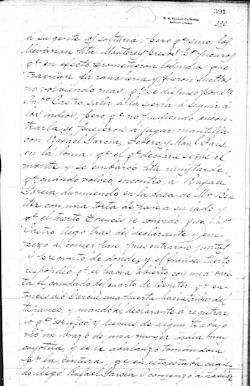
|
a su gente los soltaría; pero qe. sino, los llevarían hta. Monterey presos pr. picaros: qe. en efecto prometieron
los indios que traerían la rancheria y fueron sueltos no volviendo mas: qe. se dispuso por Dn. Anto. Castro salir á la
sierra á seguir á los indios; pero qe. no pudiendo encontrala se pusieron á jugar mantilla con Rafael García, Sebero y
Manl. Sais, en la loma: qe. el qe. declara se fué al monte y se embarcó hta. muy tarde; qe. cuando volvió, encontró a
Rafael García durmiendo en la casa de Mr. Benitez con una torta de pan á su lado, y qe. el tuerto Francés le convido:
que Anto. Castro llegó tras del declarante y empezó á comer pan pues entraron juntos y preguntó de donde, y el francés
tuerto respondió, qe. el habia abierto con una barita el candado del cuarto de Benitez: qe. entonces vió García una
puerta hacia arriba del tapanco, y mandó al declarante á registrar, lo qe. verificó y despues de algun trabajo vió un
brazo de una mujer india muy coyotita, y se le abalanzó tomándola pr. la cintura; qe. en esto estaba cuando llegó Rafael
García y comenzó á hablar |
their people he would let them go; otherwise he would take them prisoner to Monterey for being brazen: that the Indians
basically promised they would bring the village and they were let loose not returning: that Don Antonio Castro decided
to go into the hills to follow the Indians; but not being able to find them they set about playing mantilla [tossing
cow-chips, frisbee (G.Farris)] with Rafael García, Sebero and Manuel Sais, on the hill: that the witness went into the woods and toiled until
very late; that when he returned, he found Rafael García sleeping in Mr. Benitz’s house with a loaf of bread at his side,
and that the one-eyed Frenchman offered him some: that Antonio Castro arrived after the witness and began eating bread but
they entered together and he asked from where, and the one-eyed Frenchman replied, that he had used a small bar to open the
padlock to Benitz’s room: then García saw a door to the loft above, and he sent the witness to check it out, that he did
and after endeavoring a while he saw the arm of a very pretty [muy coyotita] Indian woman, and he threw himself
on her grabbing her about the waist; that he was in the midst of this when Rafael García arrived and began talking |
| | Página 392 | Page 392 |
|---|
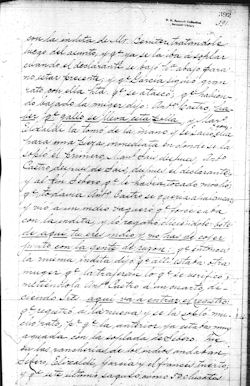
|
con la indita de Mr. Benitez. tratandola luego del asunto, y qe. ya se la iba á soplar cuando el declarante se bajó
pa. abajo para no estar presente; y qe. García siguió gran rato con ella hta. qe. se atascó; qe. habiendo bajádo la mujer
dijo: Anto. Castro, haber qe. gallo se lleva esta polla, Maro. Elizalde la tomó de la mano y se salió con ella para una
pieza inmediata en donde se la sopló él primero, Manl. Sais despues, Anto. Castro despues de Sais, despues el declarante,
y al fin Sebero qe. la habia tocado muchó; qe. todavia Anto. Castro se quería apalancar, y vió á un indio vaquero qe.
fornicaba con la indita, y lo regañó diciéndole: bote de aquí tu eres indio y no has de coger junto con la gente de razon:
qe. entonces la misma indita dijo qe. allí estaba otra mujer qe. la trajeran lo qe. se verificó, metiéndola Anto. Castro á
un cuarto, diciendo Sres. aquí vá á entrar el registro: qe. registró á la nueva y se la sopló mucho rato, pr. qe. la
anterior ya estaba muy aguada con la soplada de Sebero. Que en las rancherías de los indios andaban Sebero, Elizaldí,
García y el francés tuerto; y qe. este último saqueó como 50 chicotes |
to Mr. Benitz’s Indian girl. Discussing the situation with her, and he was about to screw her when
the witness went downstairs to not be present; and that García was with her a long time until he wore himself out; that
having taken the woman downstairs said: Antonio Castro, let’s see the cock that will have this
chick, Mario Elizalde took
her by the hand and left with her to a room next-door where he screwed her first, then Manuel Sais, then Antonio Castro
after Sais, then the witness, and finally Sebero had a long turn with her, that Antonio Castro still wanted to poke, and
seeing an Indian cowboy fornicating with the Indian girl, he scolded him saying: get out of here you are an Indian
and you can’t fuck alongside civilized people: then the same Indian girl said there was another woman there that
they should bring and that was done, Antonio Castro stuck her in a room, saying Gentlemen, this is going in the record books:
that he liked the new girl and screwed her a long while, because the first girl was already very sloppy from Sebero’s screwing.
That Sebero, Elizaldí, García and the one-eyed Frenchman were in the Indian village; and the latter looted some 50
cigars |
| | Página 393 | Page 393 |
|---|

|
qe. el declarante vió y qe. no vió otras cosas menudas, y Sebero una cora
[basquet G.Farris)]; qe. no vió mas entonces, hta. qe. al regreso
habíendose traído las inditas al rancho del declarante, una durmió con Elizaldí, la otra con Manuel Sais y una porcion con Rafael
Garcia: qe. Dn. Anto. Castro no sabe si durmió con alguna, pero qe. es muy regular qe. había cojído alguna pr. qe. estaba endemonádo
al hombre: qe. la indita dijo á Dn. Anto. Castro qe. queria estar en el rancho del declarante y no con Mr. Benitez, por que
le tenía miedo.
El testigo Rafael García dijo: qe. el dia 4 estuvo en el Presidio Ruso en compañía de Dn. Anto.
Castro y otros; y qe. habiendo llegado Castro mandó a un indio abrir la puerta de la plaza la cual estaba cerrada y puso allí
á un frances tuerto qe. llevaba: qe. el declarante despues de regresar de la sierra se metió en una sala de Mr. Benitez en
donde estaba el frances comiendo pan y carne que convidó al declarante y luego se acostó á dormir en un cajón qe. había allí
mismo: qe. cuando recordó oyó gritar arriba |
that the witness saw and that he didn’t see anything else useful, and Sebero a cora
[basket (G.Farris)]; that he then didn’t
see anything more, until the return having taken the Indian girls to the witness’s ranch, one slept with Elizaldí,
the other with Manuel Sais and a bit with Rafael Garcia; that he doesn’t know if Don Antonio Castro slept with one of them,
but it is very likely he had had one of them because he was crazy that man: that the Indian girl told Don Antonio
Castro that she wanted to stay at the witness’s ranch and not with Mr. Benitz because she was afraid of him.
The witness Rafael García said: that on the 4th he was at the Russian Fort in the company
of Don Antonio Castro and others; and that having arrived Castro sent an Indian to open the gate to the
courtyard which was
closed and he left there a one-eyed Frenchman whom he had brought: that the witness after returning from the hills entered
Mr. Benitz’s living-room where the Frenchman was eating bread and meat that he offered the witness and he later lay down
to sleep on a box that was there: that when he awoke he heard yells from |
| | Página 394 | Page 394 |
|---|
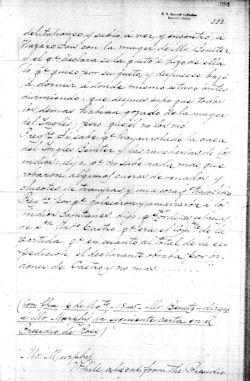
|
del tapanco y subió á ver, y encontró á Nazaro Sais con la mujer de Mr. Benitez; y el qe. declara se la quitó é
hizo de ella lo qe. quiso por su gusto, y que despues se bajó á dormir á donde mismo estuvo ántes durmiendo: que despues
supo que todos los demás habían gozado de la mujer del Inglés; pero que él no los vió
Pregdo Sí sabe qe. hayan robado la casa del Inglés Benitez y las rancherías de los indios: dijo qe. no sabe nada
mas, que robaron algunos cueros de venados y chicotes, de trampas, y un cora [basquet G.Farris]
qe. trajo Severo.
Pregdo por qe. golpearon y amarraron á los indios capitanes. dijo: qe. pr. ordenes espresas de Dn. Anto.
Castro qe. era el Comte. de la partida. qe. en cuanto al total de la expedicion, el declarante obraba por ordenes
de Castro y no mas……”
(Con fha 6 de Agto – 1845 – Mr Benetz – dirigió á Mr. Murphy la siguiente carta en
el Presidio de Ross)
Mr. Murphy,
While absent from the Presidio |
the loft above and he went up to see, and found Nazaro Sais with Mr. Benitz’s woman; and that the
witness states he took her from him and he did with her as he pleased, and that he then came down to sleep
where he had been sleeping before: that he later knew all the others had enjoyed the Englishman’s woman; but
that he hadn’t seen them.
Asked: Did he know what they had stolen from the Englishman Benitz’s house and the Indian villages:
he said that he didn’t know anything more, that they had stolen some deer
skins and cigars, traps, and Severo took a cora [basquet (G.Farris)].
Asked why they beat and tied up the Indian chiefs. he said:
at the express orders of Don Antonio Castro who was the party’s leader. that in regard to the
entire expedition, the witness was working under the orders of Castro and nothing more…”
(Dated August 6 – 1845 – Mr Benitz – wrote to Mr. Murphy the following letter from
the Presidio de Ross)
Mr. Murphy,
While absent from the Presidio |
| | Página 395 | Page 395 |
|---|
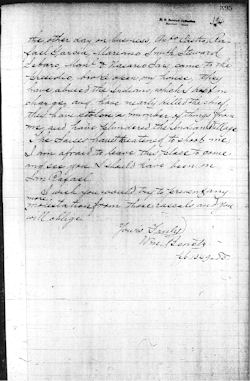
|
the other day on business, Anto. Castro, Rafael García, Mariano Smith, Steward Sebaro, Manl.
& Nasario Sais, came to the presidio, broke open my house, they have abused the Indians which
I kept in charge, and have nearly killed the chief, they have stolen a number of things from me
and have plundered the Indian Village
The Saises have threatened to shoot me, I am afraid to leave this place to come and see you.
I should have been in San Rafael.
I wish you would try to prevent any more molestation from those rascals and you will oblige.
Your Truly
Wm. Benetz.
[Timothy Murphy era un Juez de Paz (G.Farris)] |
the other day on business, Anto. Castro, Rafael García, Mariano Smith
[Mariano Elizardi (G.Farris)], Steward Sebaro [Severo Alviso (G.Farris)], Manl.
& Nasario Sais, came to the presidio, broke open my house, they have abused the Indians which
I kept in charge, and have nearly killed the chief, they have stolen a number of things from me
and have plundered the Indian Village
The Saises have threatened to shoot me, I am afraid to leave this place to come and see you.
I should have been in San Rafael.
I wish you would try to prevent any more molestation from those rascals and you will oblige.
Your Truly
Wm. Benitz.
[Timothy Murphy was a Justice of the Peace (G.Farris)] |
| Persons | Interpretación de las Abreviaturas |
Unknown Terms |
|---|
- —————— Raiders ——————
- Alviso, Sebero - possibly an Indian vaquero: José Maria Severo Alviso
- Briones, Pablo - from Marin & Sonoma counties
- Briones, Desiderio - “juez de campo”, San José
- Castro, Antonio - José Antonio Castro, San Antonio rancho
(Marin co.); Lomas Muertas
(San Benito co.) & Estanislao ranchos
- Castro, Mariano - son of Antonio Castro, San Antonio rancho
(Marin co.)
- Castro, Seberiano - unidentified
- Elizaldí, Mariano - “labrador” - i.e., farmer/rancher
- García, Rafael - Tamales & Baulinas ranchos (Marin co.), & land in Mendocino,
north of Ross
- García, Vitorico - unidentified
- Francés Tuerto - unidentified
- Mesa, joven - probably Ramon Mesa, Soulajulle rancho (Marin co.)
- Paquico - unidentified
- Saíz, Manuel - José Manuel Sáez; Manuel & Nazario were sons of
Juan Maria Sais/Sainz, who in 1843 had petitioned to use “rancho de Muniny” (Muniz
- i.e., Fort Ross)
- Saíz, Nazario - José Nazario Justo Sáez, employed by ranchos in Sonoma & Marin cos.
- Treviño, José Maria - possibly an employee of Juan Cooper
- —————— Others ——————
- Benitez, Inglés/Mr/Señor - William Benitz, Fort Ross, Muniz rancho
(Mendocino/Somoma co.)
- Cooper, Juan - Temascal rancho (Marin or Mendocino cos.)
- de la Rosa, José - “Juez Supremo de Sonoma”; Ulpinas rancho
- Felix, Fernando - Novato (Marin co.) & Sanel (Mendocino co.) ranchos
- Leecs, Luis - possibly Jacob P. Leese
- Murphy, Mr. - Timothy Murphy, Irish, “Juez de Paz” (Justice of the Peace),
Murphy / Santa Margarita rancho (Marin co.)
- Prudon, Dr. Victor - Frenchman, Sac. Isl. & Laguna ranchos (Yolo
co.)
- Suarez, Capistrano - Capistrano Juárez,
- Suarez, Cayetano - Cayetano Juárez, 1845: Alcalde at Sonoma; Tulucay (Napa valley)
& Yukya (Ukiah) ranchos
|
Agto. — Agosto
alga. — alguna
algs. — algunos
Anto. / Anto. — Antonio
Ciudo. — Ciudadano
Co. — Ciudadano
Comandte. — Comandante
Comte. — Comandante
Dn. — Don
Dr. — Doctor
dtha. — dicha
dthas. — dichas
dtho. — dicho
fha. — fecha
hta. — hasta
indivs. — individuos
Manl. — Manuel
Maro. — Mariano
Mars. — Mariano
nombe. — nombre
pa. — para
pa.po. — pasado (?)
primo. — primero
pr. — por
Pregdo. — Preguntado
qe. — que
segda. — segunda
Sn. — San
So. — Supremo
Sr. — Señor
Sor. — Señor
Sta. — Santa |
- cora — basket (per G. Farris), (p.393, 394)
- coyotita — per context: attractive, pretty, (p.391)
- lepe — homeless (per G. Farris), (p.390)
- mantilla — a game played with a head-scarf? (p.391); per G. Farris:
a game of tossing cow chips (cow-patty frisbie?).
|

